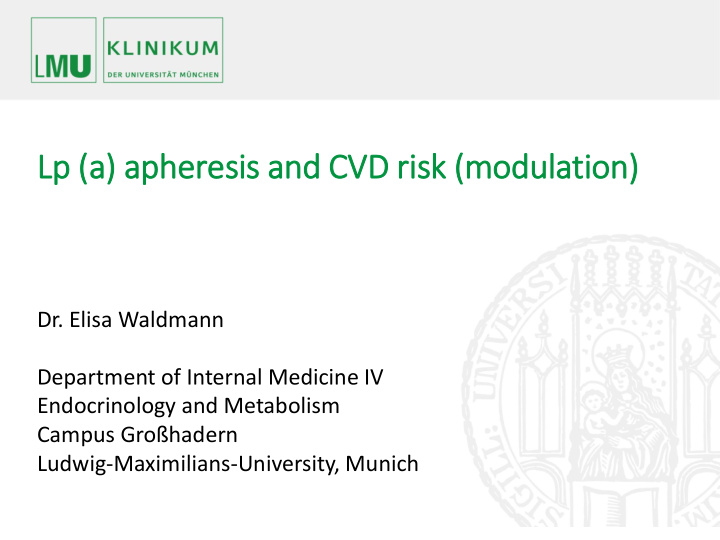



Lp (a Lp (a) ) apheresis and CVD ri risk (m (modulation) Dr. Elisa Waldmann Department of Internal Medicine IV Endocrinology and Metabolism Campus Großhadern Ludwig-Maximilians-University, Munich
Campus Grosshadern Department of Internal Medicine IV Confict of f In Interest Dis isclosure EW has received honoraria for presentations, advisory board activities or DMC acitivities by Alexion, Amgen, Boehringer-Ingelheim, Genzyme and Sanofi. EW has received research support by Alexion, Amgen, Genzyme, Novartis and Sanofi. Facts NCEP
Campus Grosshadern Department of Internal Medicine IV General Facts ▪ Apheresis is an extracorporal procedure to remove lipoproteins from the plasma of patients ▪ Veno-venous ▪ 1,5-3h weekly or biweekly ▪ app 1000€/ apheresis ▪ There are different methods how lipoproteins can be removed Syst
Campus Grosshadern Department of Internal Medicine IV LDL Lp(a) HELP: Heparin-induced extracorporal precipitation precipitation of a complex consisting of heparin, LDL, lipoprotein(a), ApoB ApoB fibrinogen and CRP at ph 5.12 LDL Lp(a) Immuno-adsorption: Anti-apoB100 antibodies plasma is passend through columns containing polyclonal anti-apoB100 ApoB ApoB antibodies Y Y Dextransulfate: electrostatic binding LDL Lp(a) electrostatic interaction of negatively charged dextransulfate and positively ApoB ApoB charged apoB +++ +++ Lipidfiltration/ membrane differential filtration LDL Lp(a) series of filters eliminate LDL and lipoprotein(a) from plasma based on size ApoB ApoB properties DALI: direct adsorption of lipoproteins LDL Lp(a) electrostatic interaction of negatively charged polyacrylate anions with ApoB ApoB positively charged apoB +++ +++ Lp(a) Lp(a) Lipopac: Anti-apoprotein(a) antibodies plasma is passed through columns containing polyclonal anti-apo(a) Apo(a) Apo(a) antibodies Y Y Waldmann & Parhofer J Lipid Res 2016 eff
Campus Grosshadern Department of Internal Medicine IV Eff ffects on lip lipoporteins NCEP Thompson Atherosclerosis 2003 (167) 1-13 Reb
Campus Grosshadern Department of Internal Medicine IV Rebound curve % 100 interval mean 50 days 7 Apheresis FCR
Campus Grosshadern Department of Internal Medicine IV Rebound aft fter apheresis Ma et al. Eur J Clin Invest. 2019 Feb;49(2):e13053 basel
Campus Grosshadern Department of Internal Medicine IV Elimination of ApoB Containing Lipoproteins Lipoprotein(a) (mg/dl) 250 200 150 100 50 0 . 1 2 3 4 5 5 6 7 8 9 10 treatments Pro(a)
Campus Grosshadern Department of Internal Medicine IV Pro (a (a) ) Li Life Klingel et al. Clin Res Cardiol Suppl. 2017 Mar;12(Suppl 1):38-43 GLAR
Campus Grosshadern Department of Internal Medicine IV German lip lipoprotein apheresis re registry (G (GLAR) Schettler et al. Clin Res Cardiol Suppl. 2019 Apr;14(Suppl 1):33-38 4S
Campus Grosshadern Department of Internal Medicine IV Similar Analysis with Data of “4S” (n=4444; CAD; simvastatin vs. placebo; 5.4 years; event rates 22.6% (placebo) vs 15.9% (simvastatin)) 2 Events per - 97% - 98% patient year 1 During study Before study During study Placebo Simvastatin Saf
Campus Grosshadern Department of Internal Medicine IV Eff ffect of f Lp Lp(a) apheresis Safarova et al Atherosclerosis Supplements 30 (2017) 166e173 Lip
Campus Grosshadern Department of Internal Medicine IV Effect of Lp(a) QCA parameters Lp(a) apheresis Atorvastatin p Value Number of coronary segments 42 segments 50 segments apheresis Percent diameter stenosis, % Baseline Mean 44.31 ± 15.95 43.68 ± 13.46 0.95 Median (95% CI) 40.00 (37.29 – 47.00) 43.50 (39.86 – 47.51) 18-month Mean 39.26 ± 13.61 48.72 ± 14.77 0.001 Median (95% CI) 36.50 (32.00 – 43.35) 49.00 (40.07 – 52.93) Mean change from baseline −5.05 ± 12.38 5.04 ± 11.43 0.0004 Median change from baseline −2.00 (−5.00– 0.00) 3.50 (0.00 – 6.93) Number with regression, n (%) 18 (43) 10 (20) 0.02* Minimal lumen diameter, mm Baseline Mean 1.39 ± 0.63 1.44 ± 0.50 0.52 Median (95% CI) 1.30 (0.99 – 1.63) 1.40 (1.17 – 1.64) 18-month Mean 1.59 ± 0.54 1.45 ± 0.65 0.08 Median (95% CI) 1.56 (1.34 – 1.73) 1.26 (1.16 – 1.58) Mean change from baseline 0.20 ± 0.39 0.01 ± 0.34 0.04 Median change from baseline 0.17 (0.03 – 0.36) 0.05 (−0.05– 0.17) Safarova et al Atherosclerosis Supplements 30 (2017) 166e173 MuSe
Campus Grosshadern Department of Internal Medicine IV Matching criteria. Mult ltiselect tria ial 1. Identical sex 2. Age ± 3 years 3. Identical ethnicity 4. Both subjects on or off PCSK9 inhibitor therapy 5. Both subjects with LDL-C in the same range of • Either between 2.6 mmol/L (100 mg/dL) and 3.39 mmol/L (129 mg/dL) • Or below 2.6 mmol/L (100 mg/dL) Hohenstein et al Atherosclerosis Supplements 30 (2017) Pro(a)
Campus Grosshadern Department of Internal Medicine IV Conclusion • Lp(a) is a respected cardiovascular risk factor • Lipoprotein apheresis reduces Lp(a) effectively • Prospective, not controlled data shows positive effect of apheresis • Plaqueregression through Lp(a) apheresis • Matched (controlled) data is in progress …
Recommend
More recommend